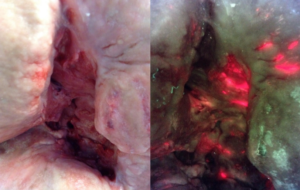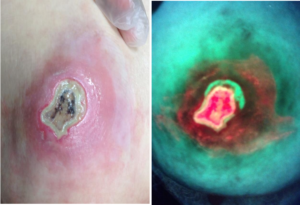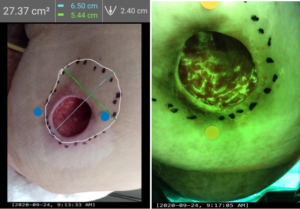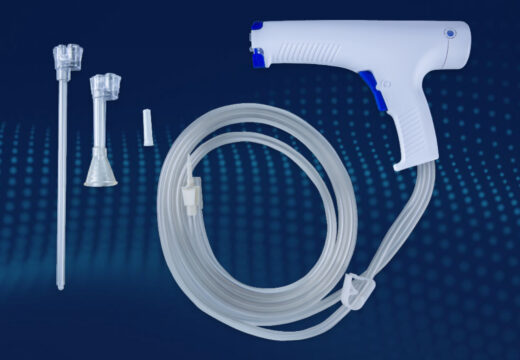
June 3, 2022
Bioluminescence Imaging and Digital Planimetry in Stage 4 Pelvic
By Dr. James B. Stiehl, MD MBA FAAOS
St Mary’s Hospital, Centralia, Illinois
Introduction:
- Digital imaging technology can enhance diagnostic and treatment strategies
- Bacterial autofluorescence (AF) is one such technology, that may be combined with digital planimetry
- In darkness, 405 nanometer violet light makes most bacteria bright red or cyan blue; compared to normal (green), blood (dark), debris (white)
- Digital planimetry with this system has an accuracy of 5% (ie. 1 mm for 2 cm wounds)
- AF has a specificity of 100% for log4 CFU/gm tissue.
- Bacterial infection defined as log4-5 CFU/gm
Methods:
- Clinical study assessing stage 4 Pelvic Pressure Injuries (Sterling IRB#6066, Atlanta, GA)
- Study protocol evaluated daily pulsatile irrigation for managing chronic infection
- Three patients identified with diagnostic dilemmas where there was evidence of significant sepsis, low grade fever, drainage,etc.
- All had Charlson Comorbidity index >7
Case #1
- 70 YO Male, 6 years Stage 4 PPI
- Start 270 sq cm to 60 sq cm-6 mos RX ➢ Placed on Xarelto for afib, aortic stenosis, stroke disease, has caval filter
- Develops malaise, wound odor, smell but wound is ‘reasonable’
- Large areas wound, peri-wound AF
- RX: Aggressive local I&D, resolved 1 wk

Case #2
- 95 YO Female, Stage 3 PPI, L Ischium
- Sudden onset, pain, redness, slough,erythema, fever, WBC 15,000

- AF reveals gross ‘red’ and subcutaneous tunnels
- Immediate I&D- 20 cc’s pus
- Planimetry shows clean 27 sq cm
- Tunneled wound (Qtip trace)

Discussion:
The findings of AF imaging were dramatic and enlightening and were remarkable to the team. We had been struggling with something ‘new’ in Case 1 and we quickly resolved it was the wound. In Case 2, there was change over 3 days and now a problem. A quick local wound incision revealed gross pus, mandating transfer to the hospital. This report describes how the compelling digital information was obtained and lead to important clinical decision making, improving outcomes.
Conclusion:
Digital imaging reveals salient, clear diagnostic impression
References:
